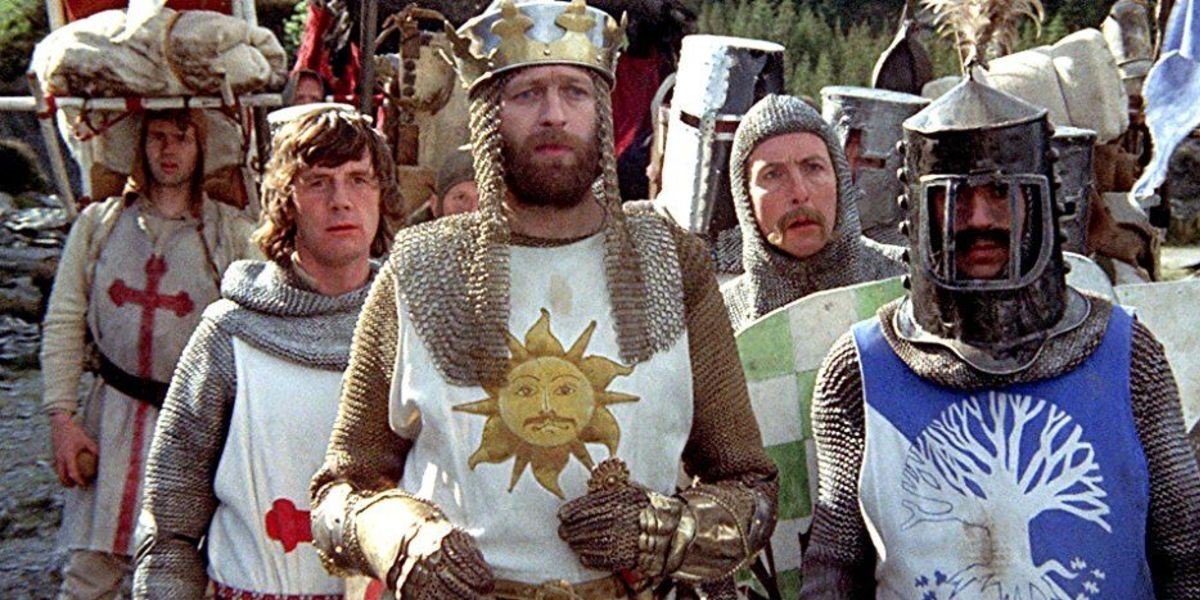After the comedy troupe known as Monty Python proved how funny they were on TV with their show Monty Python’s Flying Circus, they’d truly make it to the big leagues by making a series of films.
Monty Python consisted of Graham Chapman, John Cleese, Terry Gilliam, Eric Idle, Terry Jones, and Michael Palin. They mostly focused on absurdist and outrageous humor, where the audience couldn’t believe what they were seeing.
The first film they made was Monty Python and the Holy Grail (1975) which was directed by two members of the troupe, Gilliam and Jones.
The film is a comedic retelling of the legend of King Aurther (Graham Chapman) and the knights of the round table in their quest to retrieve the Holy Grail.

While this is a feature length film with an ongoing plot with recurring characters, the story feels sort of aimless. The plot is more of a backdrop or excuse for sketches featuring these characters.
That being said, this still is a pretty funny film.
It’s full of many absurd moments that manage to get a laugh out of the audience.
There are scenes in this film that have become iconic in their own right, such as the Black Knight saying “it’s only a flesh wound,” the French soldier’s outrageous insults to the main characters, the killer rabbit, or the Holy Hand Grenade of Antioch.
Despite the relatively low budget of 229,575 pounds (about $400,000 at the time), the makeup and costume design still look pretty good.
The thing with this film, and all of Monty Python films, is that it’s a comedy. And what a person finds comedic depends on audience, depending on how much absurdity a person can handle, they can find Monty Python’s humor either hilarious or stupid.
While Monty Python and the Holy Grail feels like a mix between their usual sketch comedy and a feature length film, their next film Monty Python’s Life of Brian is more of a traditional comedy.
The film is about Brian of Nazareth (Graham Chapman), a man born literally a stable across from Jesus Christ, who ends up taking a very different life path by joining the People’s Front of Judea (not to be confused with The Judean People’s Front). And yet through a set of bizarre occurrences, he ends up a messiah.
The film follows a traditional structure with one scene naturally flowing into another.
Despite the more cinematic structure, Brian is just as, if not more, funny than the previous film. Some great comedic examples are Pontius Pilate (Michael Palin) talking about his unfortunately named friend, a Roman soldier teaching Brian how to correctly write “Romans Go Home” in Latin, or the ending musical number.
Something worth mentioning is that the film is more outlandish than the last film, not being afraid to show full frontal at one point.
Something commendable is that, while the film does take place during Jesus’s time, it doesn’t go out of its way to make fun of religion or people of the faith mean-spiritedly.
The farthest the film goes to make fun of Christianity or Jesus, is at the beginning where some people can’t hear what Jesus is saying. And when the film does poke fun at religion itself, it isn’t going after a specific religion, just the idea of religion, and even then it’s done cleverly.
This film had more money to throw around than the last film, with a budget of $4 million, and it shows. There are a lot more extras, there are bigger sets, and more impressive makeup that still looks pretty good.
While Life of Brian took a more structured approach to its plot and its jokes, the final film, Monty Python’s the Meaning of Life, decides to go back to the sketch comedy route.
The Monty Python group have apparently discovered the meaning of life, and to show it they’ll be going over a person’s entire existence, from birth to death.
The absurdity and crassness have been turned up to 11, with sketches being almost completely nonsensical or out there.
Potentially funny or uncomfortable scenes include the exploding Mr. Creosote; a live organ donor; and children being born at random. If you thought the previous film was too over the top or offensive, I’m telling you now, this isn’t the film for you.
Because the film’s scenes are so unconnected with each other, the sketches can vary from pretty funny to boring.
Some examples of some pretty funny moments include when a man comes out of the fridge to explain the galaxy and how our existence is pretty small in the grand scheme of things, or at the end where they just state the meaning of life so matter of factly and that it seems obvious in hindsight.
But for every funny sketch there are scenes that aren’t as amusing, such as a brief intermission where two incredibly unusual people ask the audience if they can see the fish. It goes nowhere.
If you’re up for a different sort of humor that isn’t afraid to push boundaries, Monty Python could be your cup of tea.
Patrick will soon be appearing in the upcoming film about bread, The Meaning of Loaf.

